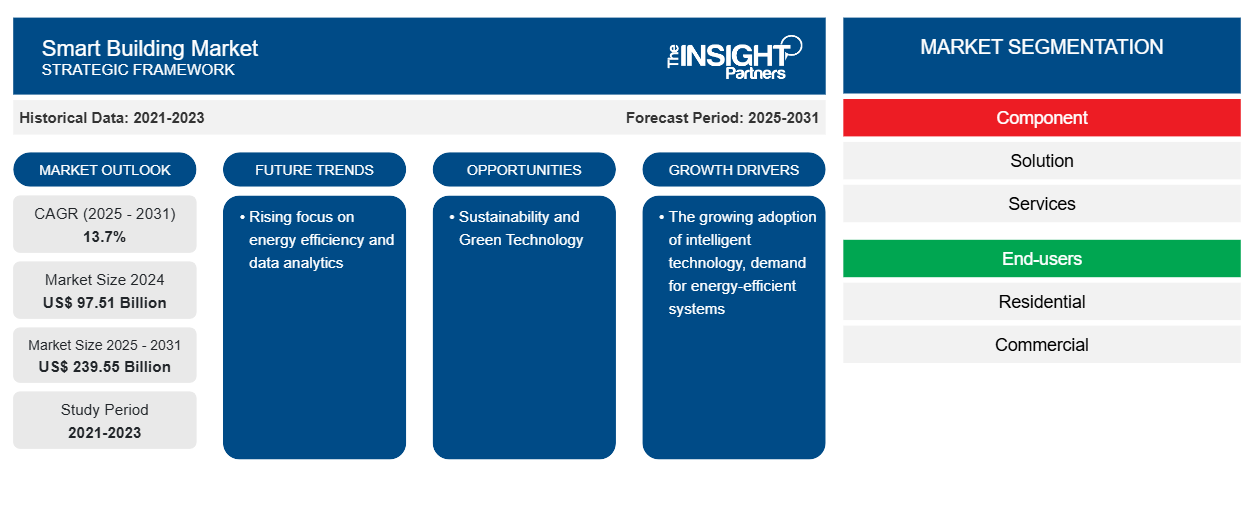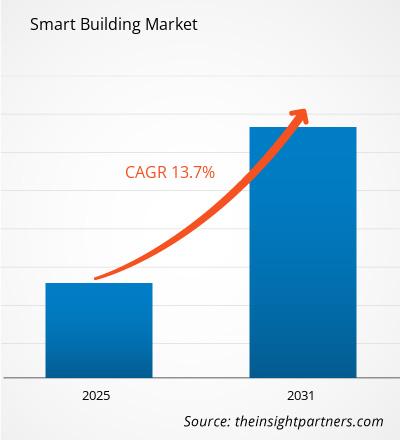预计到2031年,智能建筑市场规模将达到5343亿美元。预计2025年至2031年期间,该市场将以23.6%的复合年增长率增长。
对能源效率和数据分析日益增长的关注可能会继续成为市场的主要趋势。
智能建筑市场分析
在智能建筑市场,各种技术赋能的产品和服务正被应用于实现创新的建筑解决方案,这源于技术的进步。此外,智能家居和楼宇自动化系统的日益普及也有助于提高运营效率,从而为建筑物的顺畅运行提供必要的资产、关键部件、设备和机械。例如,目前可用的智能建筑相关解决方案包括智能安防解决方案、能源管理、楼宇自动化和网络管理等,这些解决方案都能提升建筑效率。
智能建筑市场概览
智能建筑是指利用物联网和自动化技术控制建筑服务(例如通风、供暖、空调、安防、照明等系统)的建筑形式。智能建筑通过传感器、执行器和微芯片收集和处理数据,以满足组织(或家庭)的任务和服务需求。此类智能基础设施解决方案有助于设施管理人员提高资产可靠性和性能,帮助业主和运营商降低能耗、提高空间利用率并减少建筑物对环境的影响。
您可以免费获得任何报告的定制服务,包括本报告的部分内容、国家/地区层面的分析、Excel 数据包,以及面向初创企业和高校的优惠折扣。
智能建筑市场:战略洞察

-
获取本报告的主要市场趋势。这份免费样品将包含数据分析,内容涵盖市场趋势、估算和预测等。
智能建筑市场驱动因素和机遇
智能技术的日益普及和对节能系统的需求将有利于市场发展。
智能技术的广泛应用和对节能系统的需求推动了智能建筑市场的复合年增长率。日益增长的城市化进程预计将进一步促进全球智能建筑市场的增长。鉴于城市化趋势,世界各国政府都在投资智慧城市项目,以改善基础设施、促进更清洁的交通、建设智能建筑并推广其他智能技术。人们对全球能源消耗不断增长的担忧预计将促进创新型节能技术的发展。
在大都市地区,对提高建筑利用率和优化资源管理的需求日益增长,推动了智能建筑在各国的发展。智能建筑利用物联网技术,通过自动化技术控制供暖、空调、通风、照明、安防等建筑运行系统。现代技术在智能建筑中得到广泛应用,通过传感器、执行器和微芯片收集和管理数据,从而更好地服务于组织的各项活动。智能基础设施解决方案能够降低能耗、提高空间利用率并减少建筑对环境的影响。公共安全需求的不断增长也推动了智能建筑的发展。5G技术的引入和智慧城市项目的扩展有望为智能建筑行业的蓬勃发展带来丰厚的利润前景。
可持续性和绿色技术
智能建筑的可持续性正日益受到新型物联网和人工智能技术的驱动,这些技术与环境、社会和治理(ESG)因素紧密相关。物联网传感器在能源监测和管理中发挥着重要作用。人工智能算法用于评估来自建筑运营的大量数据,从而发现趋势和低效之处。智能建筑将ESG要素融入其运营和管理中。先进的系统现在可以追踪用水量、垃圾产生量和其他资源消耗。这种改进的智能建筑可持续性方法超越了传统的建造技术,涵盖了建筑的整个生命周期和运营。
智能建筑市场报告细分分析
智能建筑市场分析的关键组成部分是组件和最终用户。
- 根据组件构成,智能建筑市场可分为解决方案和服务两大类。解决方案类别下的主要细分领域包括建筑基础设施管理、安防与应急管理以及能源管理。服务类别下的主要细分领域包括支持与维护、系统集成以及部署。2023年,解决方案类别占据了更大的市场份额。
- 按最终用户划分,市场分为住宅和商业两大类。
按地域划分的智能建筑市场份额分析
智能建筑市场报告的地理范围主要分为五个区域:北美、亚太、欧洲、中东和非洲以及南美和中美洲。
北美在市场中占据显著份额。预计智能安防系统在北美将呈指数级增长。随着环保意识的增强,越来越多的美国人寻求互联、智能和自动化的建筑解决方案,并希望获得消防、安全报警系统、监控和安防等附加功能。因此,物联网解决方案在美国越来越受欢迎。美国是北美最大的物联网市场之一,也是物联网兼容产品的最大用户。
智能建筑市场区域洞察
The Insight Partners 的分析师对预测期内影响智能建筑市场的区域趋势和因素进行了详尽的阐述。本节还探讨了北美、欧洲、亚太、中东和非洲以及南美和中美洲等地区的智能建筑市场细分和地域分布。
智能建筑市场报告范围
| 报告属性 | 细节 |
|---|---|
| 2024年市场规模 | XX亿美元 |
| 到2031年市场规模 | 5343亿美元 |
| 全球复合年增长率(2025-2031年) | 23.6% |
| 史料 | 2021-2023 |
| 预测期 | 2025-2031 |
| 涵盖部分 |
按组件
|
| 覆盖地区和国家 |
北美
|
| 市场领导者和主要公司简介 |
|
智能建筑市场参与者密度:了解其对业务动态的影响
智能建筑市场正快速增长,这主要得益于终端用户需求的不断增长,而终端用户需求的增长又源于消费者偏好的转变、技术的进步以及消费者对产品优势认知的提高。随着需求的增加,企业不断拓展产品和服务,持续创新以满足消费者需求,并把握新兴趋势,这些都进一步推动了市场增长。

- 获取智能建筑市场主要参与者概览
智能建筑市场新闻及最新发展
智能建筑市场的评估是通过收集定性和定量数据,并结合一手和二手研究成果进行的,这些研究包括重要的企业出版物、协会数据和数据库。以下列出了智能建筑市场的一些发展趋势:
- 全球领先的基础设施、交通和工业技术公司西门子与希腊领先的房地产投资公司、东南欧最大的房地产投资公司之一PRODEA Investments合作,共同部署西门子数字化建筑平台Building X。此次合作旨在加速PRODEA Investments的数字化转型,降低其希腊房地产投资组合中现有和在建建筑的碳排放,并为租户提供更多增值服务。(来源:西门子,新闻稿,2023)
- 根据2023年1月23日签署的合资协议,大林组株式会社与日立解决方案有限公司成立了合资企业Oprizon有限公司(简称“Oprizon”),旨在提供智能建筑相关服务。Oprizon于2023年4月1日正式运营,目标是成为领先的智能建筑服务提供商。(来源:日立解决方案有限公司,2023年通讯)
智能建筑市场报告涵盖范围及成果
《智能建筑市场规模及预测(2021-2031)》报告对以下领域进行了详细的市场分析:
- 智能建筑市场规模及预测,涵盖全球、区域和国家层面的所有关键细分市场。
- 智能建筑市场趋势以及市场动态,例如驱动因素、制约因素和关键机遇。
- 详细的PEST/波特五力模型和SWOT分析
- 智能建筑市场分析,涵盖关键市场趋势、全球和区域框架、主要参与者、法规以及近期市场发展动态。
- 智能建筑市场行业格局及竞争分析,涵盖市场集中度、热力图分析、主要参与者及最新发展动态
- 公司详细概况
- 历史分析(2 年)、基准年、预测(7 年)及复合年增长率
- PEST和SWOT分析
- 市场规模、价值/数量 - 全球、区域、国家
- 行业和竞争格局
- Excel 数据集
近期报告
客户评价
购买理由
- 明智的决策
- 了解市场动态
- 竞争分析
- 客户洞察
- 市场预测
- 风险规避
- 战略规划
- 投资论证
- 识别新兴市场
- 优化营销策略
- 提升运营效率
- 顺应监管趋势






















 获取免费样品 - 智能建筑市场
获取免费样品 - 智能建筑市场